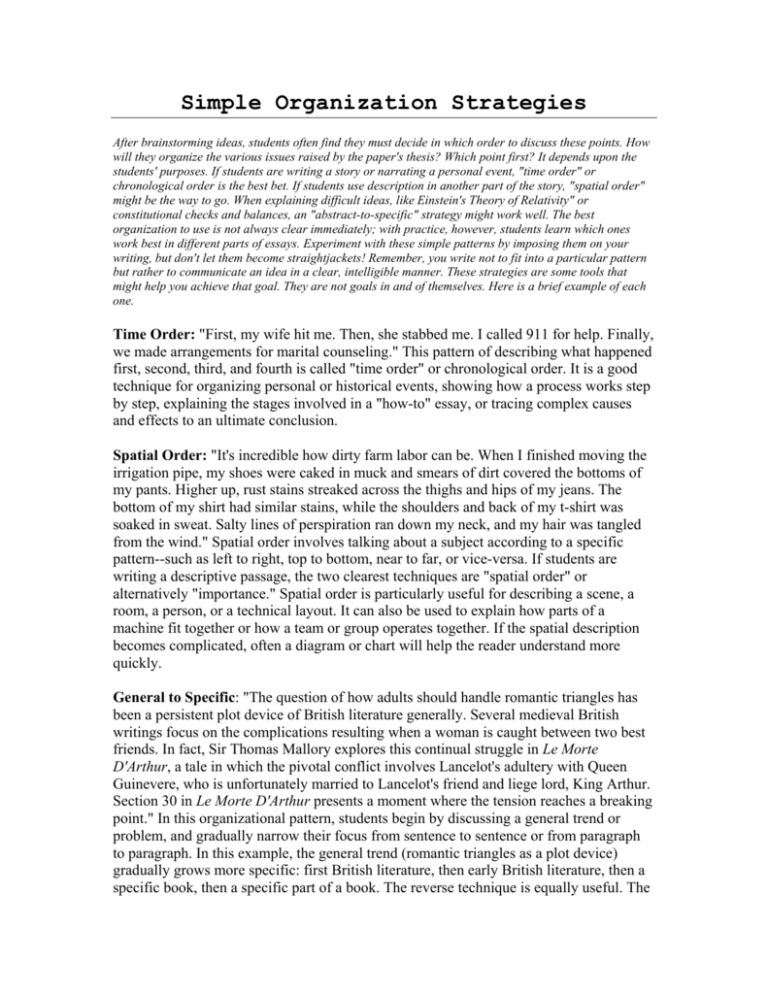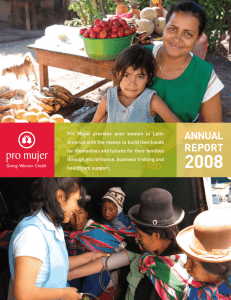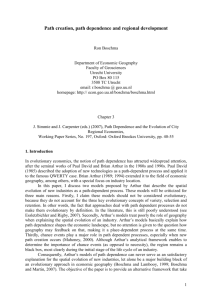Simple Organization Strategies
advertisement

Simple Organization Strategies After brainstorming ideas, students often find they must decide in which order to discuss these points. How will they organize the various issues raised by the paper's thesis? Which point first? It depends upon the students' purposes. If students are writing a story or narrating a personal event, "time order" or chronological order is the best bet. If students use description in another part of the story, "spatial order" might be the way to go. When explaining difficult ideas, like Einstein's Theory of Relativity" or constitutional checks and balances, an "abstract-to-specific" strategy might work well. The best organization to use is not always clear immediately; with practice, however, students learn which ones work best in different parts of essays. Experiment with these simple patterns by imposing them on your writing, but don't let them become straightjackets! Remember, you write not to fit into a particular pattern but rather to communicate an idea in a clear, intelligible manner. These strategies are some tools that might help you achieve that goal. They are not goals in and of themselves. Here is a brief example of each one. Time Order: "First, my wife hit me. Then, she stabbed me. I called 911 for help. Finally, we made arrangements for marital counseling." This pattern of describing what happened first, second, third, and fourth is called "time order" or chronological order. It is a good technique for organizing personal or historical events, showing how a process works step by step, explaining the stages involved in a "how-to" essay, or tracing complex causes and effects to an ultimate conclusion. Spatial Order: "It's incredible how dirty farm labor can be. When I finished moving the irrigation pipe, my shoes were caked in muck and smears of dirt covered the bottoms of my pants. Higher up, rust stains streaked across the thighs and hips of my jeans. The bottom of my shirt had similar stains, while the shoulders and back of my t-shirt was soaked in sweat. Salty lines of perspiration ran down my neck, and my hair was tangled from the wind." Spatial order involves talking about a subject according to a specific pattern--such as left to right, top to bottom, near to far, or vice-versa. If students are writing a descriptive passage, the two clearest techniques are "spatial order" or alternatively "importance." Spatial order is particularly useful for describing a scene, a room, a person, or a technical layout. It can also be used to explain how parts of a machine fit together or how a team or group operates together. If the spatial description becomes complicated, often a diagram or chart will help the reader understand more quickly. General to Specific: "The question of how adults should handle romantic triangles has been a persistent plot device of British literature generally. Several medieval British writings focus on the complications resulting when a woman is caught between two best friends. In fact, Sir Thomas Mallory explores this continual struggle in Le Morte D'Arthur, a tale in which the pivotal conflict involves Lancelot's adultery with Queen Guinevere, who is unfortunately married to Lancelot's friend and liege lord, King Arthur. Section 30 in Le Morte D'Arthur presents a moment where the tension reaches a breaking point." In this organizational pattern, students begin by discussing a general trend or problem, and gradually narrow their focus from sentence to sentence or from paragraph to paragraph. In this example, the general trend (romantic triangles as a plot device) gradually grows more specific: first British literature, then early British literature, then a specific book, then a specific part of a book. The reverse technique is equally useful. The most common use is to set up an introduction or conclusion, but in logical argument, the technique works well to prove a point about deductive or inductive reasoning as well. Comparison / Contrast: "Both Lady Jane Grey and Queen Elizabeth I had certain similarities. They were both potential female rulers in a world normally dominated by men. Both of them had legitimate but hotly contested claims on the British throne. Both were profoundly influenced by their religious convictions and their sense of religious duty, and both were young and pressured by older relatives. In contrast, Elizabeth's Protestant leanings were a world away from Lady Jane's unshakable Catholicism. Elizabeth found ways to circumvent masculine control of her power, while Jane was always the dupe of her relatives. Elizabeth's claim to the throne was bolstered widely by parliament, while Jane's claim was limited to immediate family." This strategy takes two people, objects, or situations. It systematically goes through point-by-point comparison, contrast, or both comparison and contrast. With some degree of success, it can be applied to nearly any two topics in the same category. Abstract to Concrete: "The theory of quantum mechanics is like a card game with elaborate rules. For instance, in poker, some cards can be designated 'wild cards.' These wild cards can have a variety of effects as designated by the dealer, and other players will not be able to predict how they will influence the game until the dealer designates their value. Quantum mechanics and the uncertainty principle work much the same way. Subatomic quarks, like wild cards, are unpredictable. Their location and their movement cannot be determined in advance, and the act of determining their location or their movement alters their behavior, making it impossible for scientists to accurately determine their subatomic effects." This specialized form of comparison and contrast seeks to compare a difficult or abstract concept to a common, everyday phenomenon the reader can easily understand. The reader might spend several sentences or paragraphs discussing both by alternating between the easy-to-understand metaphor and the more difficult abstraction. Importance: "If my room ignited, and the fire threatened to destroy my belongings, I would run past the trash can, past the heap of dirty laundry, past my wallet, and past my checkbook, so I could grab my beloved English textbook and race for the door." This strategy involves moving from the least important point or item toward items of increasing importance. The idea is that the reader will grow increasingly impressed with the improving quality of ideas or discussion, and the essay will accordingly end dramatically. The reverse technique, moving from most important to least important, is also do-able if the writer wants to "front-load" his paper with the strongest points early (though this can lead to an anticlimactic conclusion). Magician's Trick: Stage magicians commonly order a magic show in a particular order. They place their second-best trick first in the show to engage the audience. They save their very best trick for last, hoping to end on a triumphant, memorable note. They throw everything else in the middle. This variant of "Importance" as an order makes a great deal of sense when it comes to having a strong introduction and a memorable conclusion, but not all essays lend themselves easily to this format.









